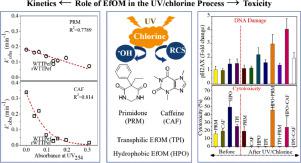Water Research ( IF 11.4 ) Pub Date : 2021-09-07 , DOI: 10.1016/j.watres.2021.117634 Yuru Wang 1 , Mauricius Marques Dos Santos 2 , Xinxin Ding 3 , Jérôme Labanowski 4 , Bertrand Gombert 4 , Shane Allen Snyder 2 , Jean-Philippe Croué 4

|
The UV/chlorine process as a potential tertiary municipal wastewater treatment alternative for removing refractory PPCPs has been widely investigated. However, the role of effluent organic matter (EfOM) on the radical chemistry and toxicity alteration is unclear. The elimination of two model PPCPs, primidone (PRM) and caffeine (CAF), by the co-exposure of UV and free chlorine was investigated to elucidate the impact of EfOM. Experimental results indicated that both •OH and reactive chlorine species (RCS) were importantly involved in the decay of PRM at acidic condition, while ClO• played dominant role at alkaline pH. The decay of CAF was dominated by ClO• under all conditions. Chlorine dose, initial contaminant concentration, solution pH, and water matrix affect the process efficiency at varying degree resulting from their specific effect on the radical speciation in the system. Presence of EfOM isolate remarkably inhibited the decay of PRM and CAF by preferentially scavenging RCS and particularly ClO•. Good correlations (linear for PRM and exponential for CAF) between UV absorbance at 254 nm and the observed pseudo first-order rate constants (k'obs) for all EfOM solutions were obtained, demonstrating the importance of aromatic moieties in inhibiting the degradation of targeted contaminants by UV/chlorine process. Degradation of PRM/CAF in reconstituted effluent spiked with the major effluent constituents (i.e., EfOM isolates, Cl-, HCO3-, and NO3-) was comparable to the results obtained with the real WWTP effluent and fit well to the correlation between k'obs and UV absorbance at 254 nm, suggesting that EfOM isolates can be used to determine the efficiency of UV/chlorine process in real effluent. EfOM serves as the main precursor of adsorbable organic chlorine in the UV/chlorine treatment. Bioassays indicated that chlorine-containing compounds could induce oxidative stress, mitochondrial dysfunction, and increase the cell DNA damage. Among evaluated treatment conditions, the nature of EfOM, hydrophobic versus transphilic fraction, is likely the predominant factor affecting the cytotoxicity. Meanwhile the UV/chlorine treatment can significantly reduce the cytotoxicity of EfOM isolates. However, adding high level of selected contaminants (e.g., PRM and CAF) can inhibit this phenomenon due to the competition with reactive radicals.
中文翻译:

EfOM 对通过紫外线/氯消除 PPCP 的影响:自由基化学和毒性生物测定
紫外线/氯工艺作为潜在的三级市政废水处理替代方案,用于去除难处理的 PPCPs 已得到广泛研究。然而,流出物有机物(EfOM)对自由基化学和毒性改变的作用尚不清楚。研究了通过紫外线和游离氯的共同暴露消除两种模型 PPCP,扑米酮 (PRM) 和咖啡因 (CAF),以阐明 EfOM 的影响。实验结果表明• OH 和活性氯物质 (RCS) 在酸性条件下对 PRM 的衰变有重要影响,而 ClO •在碱性 pH 值下起主导作用。CAF 的衰变主要是 ClO •在所有条件下。氯剂量、初始污染物浓度、溶液 pH 值和水基质因它们对系统中自由基形态的特定影响而在不同程度上影响工艺效率。EfOM 分离物的存在通过优先清除 RCS 和特别是 ClO •显着抑制了 PRM 和 CAF 的衰减。在 254 nm 处的紫外吸光度与观察到的所有 EfOM 溶液的伪一级速率常数 (k' obs ) 之间获得了良好的相关性(PRM 的线性关系和 CAF 的指数关系),证明了芳香族部分在抑制靶向降解方面的重要性紫外线/氯过程中的污染物。PRM/CAF 在加入主要流出物成分(即 EfOM 分离物、Cl-、HCO 3 -和 NO 3 - ) 与实际污水处理厂出水所得结果相当,并且与 k' obs之间的相关性非常吻合和 254 nm 处的紫外吸光度,表明 EfOM 分离物可用于确定实际废水中紫外/氯工艺的效率。EfOM 在紫外线/氯处理中用作可吸附有机氯的主要前体。生物测定表明,含氯化合物可诱导氧化应激、线粒体功能障碍并增加细胞 DNA 损伤。在评估的治疗条件中,EfOM 的性质、疏水性与转嗜性部分可能是影响细胞毒性的主要因素。同时紫外线/氯处理可以显着降低 EfOM 分离株的细胞毒性。然而,由于与活性自由基的竞争,添加高水平的选定污染物(例如,PRM 和 CAF)可以抑制这种现象。











































 京公网安备 11010802027423号
京公网安备 11010802027423号